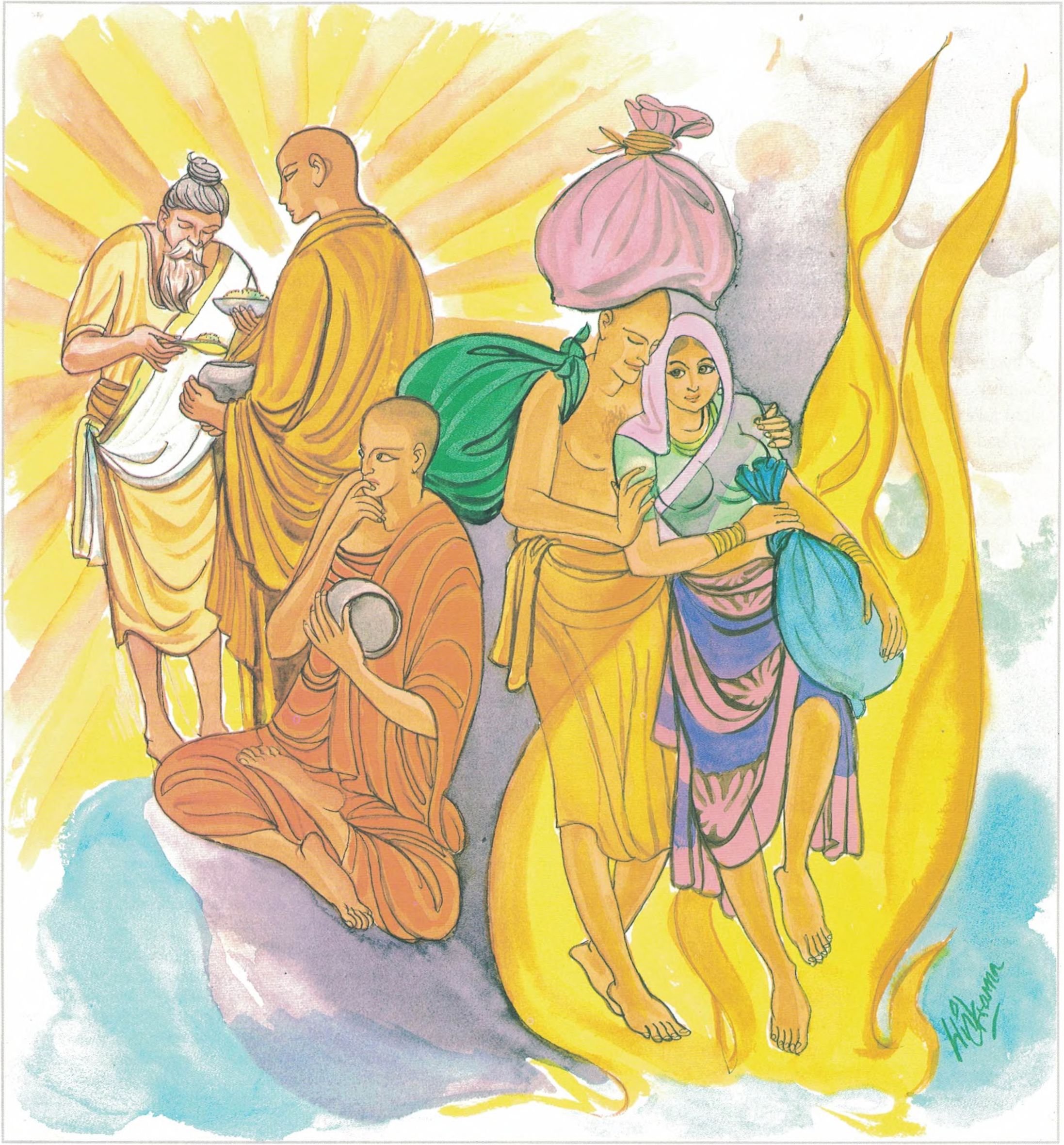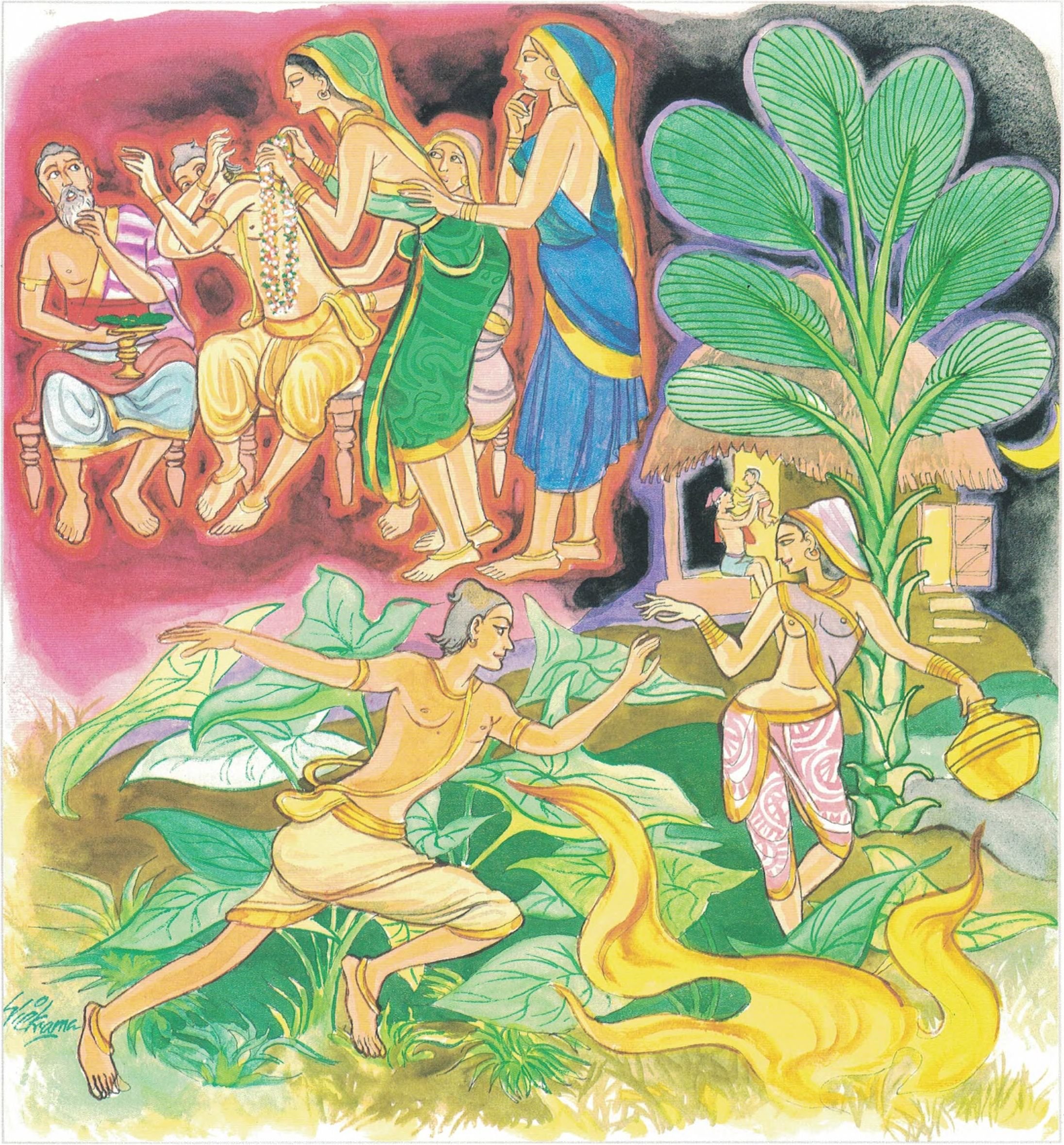Dhammapada (Illustrated)
by Ven. Weagoda Sarada Maha Thero | 1993 | 341,201 words | ISBN-10: 9810049382 | ISBN-13: 9789810049386
This page describes The Story of A Group of Bad Ascetics which is verse 316-317 of the English translation of the Dhammapada which forms a part of the Sutta Pitaka of the Buddhist canon of literature. Presenting the fundamental basics of the Buddhist way of life, the Dhammapada is a collection of 423 stanzas. This verse 316-317 is part of the Niraya Vagga (Hell) and the moral of the story is “Those ashamed of what is not shameful, and unashamed of the shameful are all hell-bound” (first part only).
Verse 316-317 - The Story of A Group of Bad Ascetics
Pali text, illustration and English translation of Dhammapada verse 316-317:
alajjitāye lajjanti lajjitāye na lajjare |
micchādiṭṭhisamādānā sattā gacchanti duggatiṃ || 316 ||
abhaye bhayadassino bhaye cā'bhayadassino |
micchādiṭṭhisamādānā sattā gacchanti duggatiṃ || 317 ||
316. Those fearing what they should not, fearing not what they should are destined for birth in hell.
317. They are afraid where there is not but where is fear are unafraid, so by embracing evil views beings go to an evil birth.
 Those ashamed of what is not shameful, and unashamed of the shameful are all hell-bound. |
 Those fearing what they should not, fearing not what they should are destined for birth in hell. |
The Story of A Group of Bad Ascetics
While residing at the Jetavana Monastery, the Buddha spoke these verses, with reference to Nigaṇṭha ascetics, who covered only the front part of their bodies.
One day, some Nigaṇṭhas went on an alms-round with their bowls covered with a piece of cloth. Some monks, seeing them, commented, “These Nigaṇṭha ascetics who cover the front part of the body are more respectable compared to those Acelaka ascetics who go about without wearing anything.” Hearing this comment, those ascetics retorted, “Yes, indeed, we do cover up our front part (by covering our bowls); but we cover it up not out of shame in going naked. We only cover up our bowls to keep away dust from our food, for even dust contains life.”
When the monks reported what the Nigaṇṭha ascetics said, the Buddha replied, “Monks, those ascetics who go about covering only the front part of their bodies are not ashamed of what they should be ashamed of, but they are ashamed of what they should not be ashamed of; because of their wrong view they will only go to bad destinations.”
Explanatory Translation (Verse 316)
alajjitāye lajjanti lajjitāye na lajjare micchā
diṭṭhi samādānā sattā duggatiṃ gacchanti
alajjitāye: in what one should not be ashamed of; lajjanti: (if someone) were to be ashamed; lajjitāye: and in what one should be ashamed of; na lajjare: one is not ashamed; micchā diṭṭhi samādānā: embracing false beliefs; sattā: these beings; duggatiṃ [duggati]: to woeful states (hell); gacchanti: depart
Those who are ashamed of what they should not be ashamed of, and those who are unashamed of what they should be ashamed of, all those who embrace false views go to woeful states (hell).
Explanatory Translation (317)
abhaye bhayadassino, bhaye cabhayadassino
micchādiṭṭhisamādānā sattā duggatiṃ gacchanti
abhaye: in what should not be afraid of: bhayadassino ca: those who see fear; bhaye: in what should be afraid of; abhayadassino ca: seeing no fear; micchādiṭṭhisamādānā: embracing false beliefs; sattā: those beings; duggatiṃ [duggati]: to woeful states (hell); gacchanti: depart
There are some who are afraid of what they should not fear. There are also some who are not afraid of what they should really fear. They all, who embrace false beliefs, go to woeful states.
Commentary and exegetical material (Verse 316-317)
This was occasioned by the behaviour of group of nigaṇṭhas (naked ascetics). In Buddha’s day Jambudīpa teemed with various spiritual and religious systems led by a variety of persons.
There are frequent references in Buddhist literature to some six senior contemporaries of the Buddha, for instance, in the dīgha-nikāya (the Sāmaññaphala-sutta and its counterpart in Sanskrit). It appears from the contact of these references that Ajātasatru, the king of Magadha, met a number of these teachers and asked them each separately to state in clear and unambiguous terms the result of their ascetic practices. All of them were well known in the country as founders of religious schools with a large following. Their names and the special doctrines they held are briefly stated in the text. It is possible, however, that the information supplied is prejudiced as it emanates from their opponents; in fact, the mis-statements they make are partly due to design and partly to ignorance. All the same, it is interesting to study their views in order to understand correctly as well as to appreciate the views of the founder of Buddhism.
Of these six thinkers, Nigaṇṭha Nātaputta, who is none other than Mahāvīra, the founder, or according to the Jaina tradition, the last prophet of the present world cycle, seems to have been slightly older than the Buddha. He preached ethical doctrines without apparently knowing that similar ideas had been held by an incomparably senior ascetic, Pārsva. The latter is now acknowledged to be Mahāvīra’s predecessor and is believed to have lived two hundred and fifty years before Mahāvīra. Pārsva’s ethical code consisted of four rules, whereas that of Mahāvīra consisted of five. Of these, the first three, viz., not to kill living things, not to take articles of use unless they are given, and not to tell a lie, are common to the schools of both Pārsva and Mahāvīra. The fourth rule in Pārsva’s teaching, that of aparigraha, not to have any worldly possessions including a wife, was split up into two by Mahāvīra to make up his code of five. Not to take a wife, or to lead a celibate life, which is the fourth rule in Mahāvīra’s code, and not to have worldly possessions except clothes, which is the fifth rule in Mahāvīra’s code, seem to constitute jointly the fourth rule of Pārsva. The main difference in the practical or external aspects of Pārsva’s and Mahāvīra’s code of conduct thus seems to have been that while Pārsva and his followers were acelakās or naked, Mahāvīra and his followers wore white garments, but refused to have any other paraphernalia. In other words, the Jaina faith as preached by Mahāvīra is the same as Pārsva’s, but somewhat more modern. It was natural therefore that these two schools should have become one as they actually did some two hundred and fifty years after the death of Pārsva, when the disciples of Pārsva and those of Mahāvīra met at Srāvasti and brought about the union. Later, the Jainas explained this fusion of schools differently by adding twenty-two prophets to precede Pārsva, thereby making Pārsva the twenty-third and Mahāvīra the twenty-fourth of their prophets. It would, however, be quite correct to hold that Pārsva and Mahāvīra independently evolved a philosophy and a religious system which had identical tenets.
In the Sāmaññaphala-sutta Nigaṇṭha Nātaputta is mentioned as having held the doctrine of four-fold restraint: restraint from the use of cold water as it contains life, and from sinful activities such as killing and sexual intercourse. He was free from all sins and had purified himself. In the Udumbarika-sīhanāda-sutta the restraints ascribed to him are different, but identical with the four vows of Pārsva.
According to Jaina sources, however Jainism is not a purely ethical system, but also a philosophy based on the doctrine of many possibilities, known as anekānta or syādvāda. The doctrine looks at two aspects of everything, the eternal and the non-eternal. The soul undergoes migration according to good or bad deeds. As Jainism regards the existence of jīva (life) in everything, it enjoins such behaviour as does not cause injury to any jīva. The soul becomes impure and is engulfed by saṃsāra if it is subjected to the influence of sense objects. in order to keep the soul pure from their contamination, and to secure its release, it is necessary to practice restraint. To achieve this one must resort to or acquire right knowledge, faith and conduct. Buddhist sources, for instance the Aṅguttara, and the seventy-four sutta of the ekanipāta, ridicule the Jaina doctrine, particularly its idea of overcoming sin, its restraint on movements and its insistence on certain types of clothing.
The next important contemporary of the Buddha was Makkhali Gosāla. He belonged to the sect of the acelakās or naked ones, and, as the first part of his name indicates, carried a staff of bamboo (maskarin). It is said that he was, for some time, a disciple of Mahāvīra, but later broke away from him. Afterwards, he probably founded an independent school known as the Ājīvika school. Later writers mention two predecessors, Nanda Vaccha and Kisa Saṃkicca, thus giving this school three prophets. This sect is now extinct, but seems to have enjoyed popularity and even royal patronage. The doctrine advocated by Gosāla is styled saṃsāra-visuddhi or the doctrine of attaining purity only by passing through all kind of existence. Gosāla did not believe that there was any special cause for either the misery of human beings or for their deliverance. He did not believe in human effort, and held that all creatures were helpless against destiny. He maintained that all creatures, whether wise or foolish, were destined to pass through saṃsāra and that their misery would come to an end at the completion of the cycle. No human effort would reduce or lengthen this period. Like a ball of thread, saṃsāra had a fixed term through which every being must pass.
The remaining four teachers, who are mentioned as contemporaries of the Buddha, did not leave their mark on posterity as did Mahāvīra and, to a lesser degree, Gosāla.
